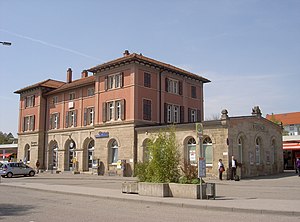Marbach (Neckar) station
| Junction station | |
 |
|
| Location |
Marbach am Neckar, Baden-Württemberg Germany |
| Coordinates | 48°56′37″N 9°15′52″E / 48.94361°N 9.26444°ECoordinates: 48°56′37″N 9°15′52″E / 48.94361°N 9.26444°E |
| Line(s) |
|
| Platforms | 3 |
| Other information | |
| Station code | 244 |
| DS100 code | TMB |
| IBNR | 8003853 |
| Category | 4 |
| History | |
| Opened | 8 December 1879 |
Marbach (Neckar) station serves the town of Marbach in the German state of Baden-Württemberg. It is the terminus for line S 4 of the Stuttgart S-Bahn and Regionalbahn trains from Backnang. Until 1966, this was the starting point of the Bottwar Valley Railway (Bottwartalbahn), which ran all the way to Heilbronn Süd station.
The Backnang–Bietigheim line was built by the Royal Württemberg State Railways as part of a new east–west link from the Bavarian border at Crailsheim to the Baden border at Mühlacker. The town council of Marbach had long petitioned the government for a connection to the railway network, which the new line would provide. Construction began in 1875. A huge iron truss viaduct with sandstone pillars was built over the Neckar valley between Marbach and Benningen. The station was built about half a kilometre northeast of the centre of the town. The station building, which is still preserved, was more impressive than the others on the line. The central building and its two side projections are three storeys high. The walls of the ground storey are built of sandstone and the upper storeys are brick. The freight shed, built at that time, also still exists.
On 8 December 1879, the railway line was taken into operation along with Marbach station. A short time later, the station was renamed Marbach (Neckar) to distinguish it from the station of Marbach (now in Villingen-Schwenningen) in Baden on the Black Forest Railway.
Passenger traffic on the line was initially moderate, but increased in 1881 with the completion of the connection between Beihingen (now part of Freiberg am Neckar) and Ludwigsburg. Beihingen-Heutingsheim was considered as a possible starting point of the Bottwar Valley Railway, but Marbach’s advantages prevailed. The tracks of the narrow-gauge railway were on the northern side of the station. Its equipment included a turntable, a goods shed and a Rollbock facility for transferring standard gauge freight wagons. In 1894 the first trains ran to Beilstein and in 1900 the line was extended to Heilbronn Süd station. In 1906, a single storey extension was added to the station building on the eastern side to accommodate additional premises.
...
Wikipedia
